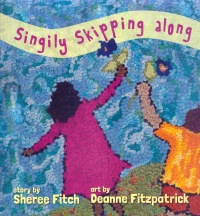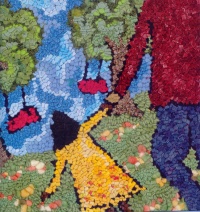| ________________
CM . . .
. Volume XX Number 22. . . .February 7, 2014
excerpt:
Sheree Fitch’s Singily Skipping Along nurtures creativity in young children through the use of imaginative prose and engaging illustrations. On every spread, readers are asked to imagine themselves as something new, anything from a leaf to a song, and consider how it would feel. Deanne Fitzpatrick’s illustrations add richness and tactile depth to this pretend play.
Since this book was intended for young children who are not yet able to read independently, in addition to illustrations, the text borrows strategies from concrete or shape poetry to help convey meaning to these pre-readers. In the line “There’s no other huggily” (p. 28), the text of invented word huggily, with its roots in the word “hug,” is squeezed in the middle as if were being embraced by unseen arms. This visual cue aids the young reader in deciphering the meaning of the text. The fonts are also manipulated to ease understanding: “This a rose/ I am a thorn/ I am a-prickly” (p. 12) uses a font that has sharp spikes for the word “prickly,” similar to thorns on a rose bush. The use of this font helps children to apply words to their real-life experiences, such as an unpleasant encounter with a rose bush. To further emphasize this connection, Fitzpatrick’s illustrations usually provide a direct visual link to the text. In this scene, her rug shows a girl with her arms wrapped tightly against the stem of a giant rose, pretending that she is a thorn. Upon an initial reading, adult readers may have difficulty with Fitch’s nonsense words, but considering the intended audience of the book, it makes sense. With the use of invented words, Fitch is encouraging young children to embrace language as they are exposed to new experiences and seeking imaginative ways of describing these foreign things. Rather than focussing on rigidly learning proper English, she fosters the understanding the communicative aspect of language in her readers. “I am a-squirmily/ Warming the ground” (p. 17) may sound like nonsense to an adult reader, but to a young child, this is an invitation to pretend that he is a worm squirming on the ground and imagine what it is like to be a worm. Fitch’s simple structure, “This is a [ ]/ I am a [ ],” helps young children to draw connections between related people, ideas and objects. Her first three scenes repeat the object, “This is a stone/ I am a stone” (p. 5), which allows readers to warm up their imaginations before moving onto more complex connections. The next scenes feature part-of-a-whole relationships, such as “This is a lake/ I am a duck” (p. 8), and young readers are asked to imaginatively figure out how they fit into a larger context. This creative activity mirrors the development that takes place as a child begins to recognize that he is part of a bigger world. The final scenes of the book feature people relationships, such as a mother and son, and emphasizes the uniqueness of each person: “There’s no other you like you/ There’s no other me like me” (p. 29). While Singily Skipping Along has an interesting approach and luminous illustrations, it is difficult to read aloud. Between the use of invented words and the lack of a consistent metre, adult readers can find it difficult to keep up a rhythm as they are reading the book. Nevertheless, Singily Skipping Along has a place in early childhood educators’ collections as a tool for inspiring young imaginations. Recommended. Sabrina Wong is a librarian at the University of Calgary in Calgary, AB.
To comment
on this title or this review, send mail to cm@umanitoba.ca.
Copyright © the Manitoba Library Association. Reproduction for personal
use is permitted only if this copyright notice is maintained. Any
other reproduction is prohibited without permission.
NEXT REVIEW |
TABLE OF CONTENTS FOR THIS ISSUE
- February 7, 2014.
AUTHORS |
TITLES |
MEDIA REVIEWS |
PROFILES |
BACK ISSUES |
SEARCH |
CMARCHIVE |
HOME |

 Fitzpatrick, a rug-hooking artist whose works are in a number of Canadian museums and galleries, created stunning rugs to illustrate Fitch’s text. Even though they were photographed for the illustrations, the careful detail and texture of the rugs comes through and gives the illustrations depth and visual interest. Young readers will be drawn to her use of bold and vibrant colours and the variety of textures created by the use of different ribbons and yarns in her rugs. While Fitch’s prose is appealing, the use of Fitzpatrick’s rugs in this book is fresh and innovative. It gives new life to a form of art formerly seen as old-fashioned and fits well with the recent rise in popularity of handicrafts.
Fitzpatrick, a rug-hooking artist whose works are in a number of Canadian museums and galleries, created stunning rugs to illustrate Fitch’s text. Even though they were photographed for the illustrations, the careful detail and texture of the rugs comes through and gives the illustrations depth and visual interest. Young readers will be drawn to her use of bold and vibrant colours and the variety of textures created by the use of different ribbons and yarns in her rugs. While Fitch’s prose is appealing, the use of Fitzpatrick’s rugs in this book is fresh and innovative. It gives new life to a form of art formerly seen as old-fashioned and fits well with the recent rise in popularity of handicrafts.